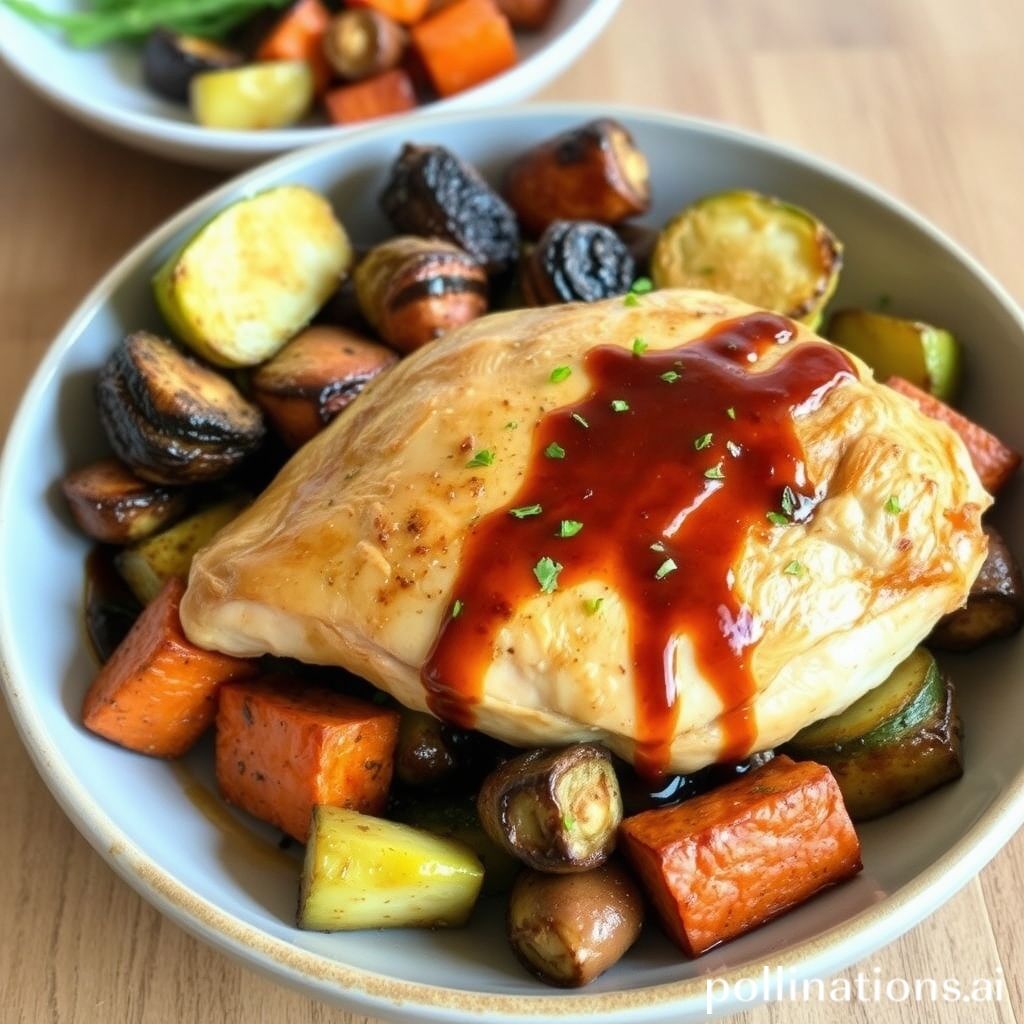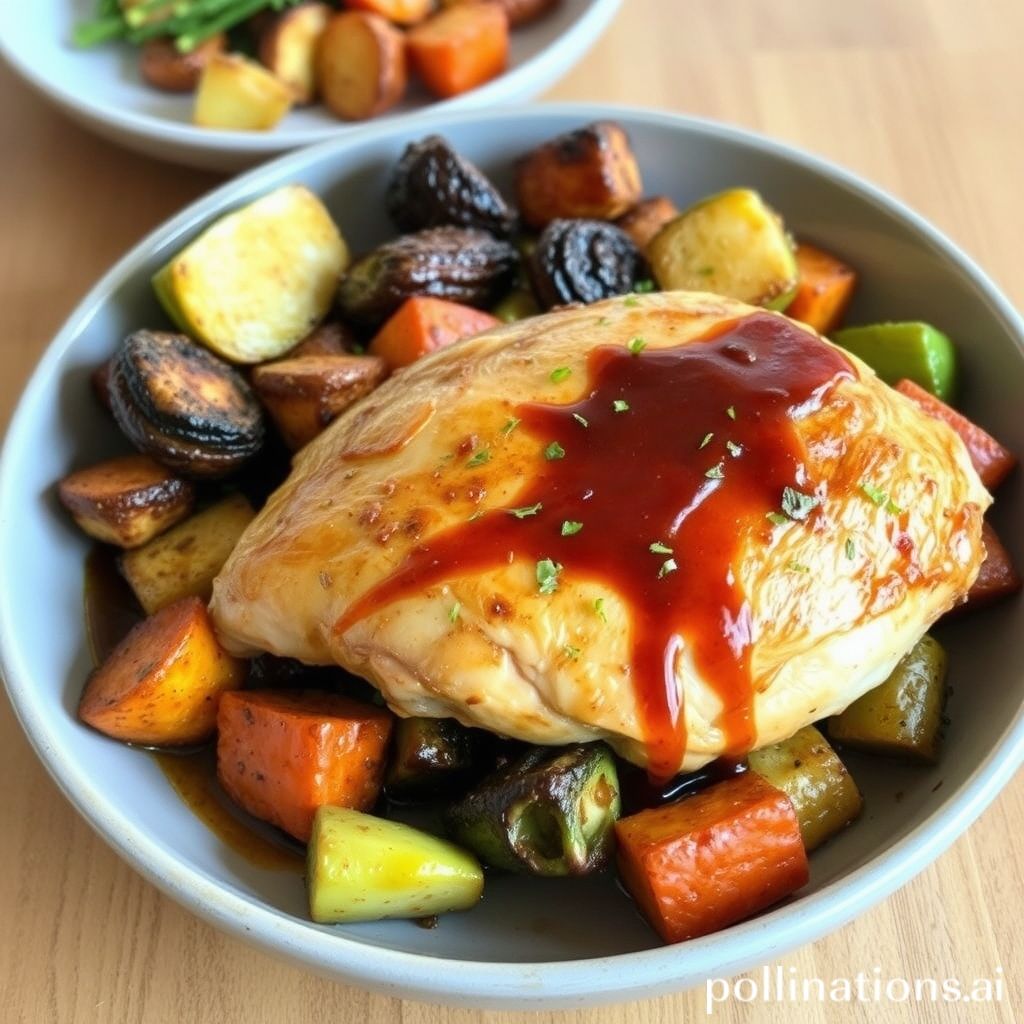Table of Contents
- Introduction
- The significance of balsamic vinegar in enhancing the flavor of chicken
- Key ingredients for making Balsamic Glazed Chicken with Roasted Vegetables
- Step-by-step guide to preparing and marinating the chicken
- Roasting vegetables for optimal flavor and texture
- Cooking techniques for achieving the perfect balsamic glaze
- Health benefits of incorporating roasted vegetables into your meal
- Pairing suggestions: What to serve with Balsamic Glazed Chicken with Roasted Vegetables
- Tips for presentation and garnishing to elevate your dish
- Conclusion
- Frequently Asked Questions
Introduction

Imagine savoring a dish where every bite is a symphony of flavors, textures, and aromas. Welcome to the world of Balsamic Glazed Chicken with Roasted Vegetables, a culinary masterpiece that promises to elevate your dining experience. Unveiling a delightful balance of zesty balsamic glaze and tender chicken, this recipe is not just another dinner idea—it’s an invitation to explore the culinary artistry that transforms simple ingredients into a gourmet delight.
What makes this dish stand out is its seamless blend of sweet, tangy, and savory notes. Visualize succulent chicken breasts enveloped in a rich balsamic glaze, accompanied by a vibrant medley of carrots, zucchini, and bell peppers that roast to perfection, releasing their natural sweetness. This recipe is perfect for those who appreciate the finer details of cooking without the complexity—proof that even a weekday dinner can feel like a special occasion.
So, whether you’re a culinary novice or a seasoned home cook, this exquisite recipe offers something for everyone—speed, simplicity, and of course, sumptuousness.
The significance of balsamic vinegar in enhancing the flavor of chicken
Balsamic vinegar plays an essential role in enhancing the flavor profile of chicken dishes, adding a distinct sweet and tangy taste that complements the savory nature of the meat. Its rich, deep flavor is developed through a meticulous aging process, which allows the vinegar to acquire complex notes of wood, fruit, and spice. When used as a glaze or marinade, balsamic vinegar penetrates the chicken, tenderizing the meat while infusing it with a robust flavor.
The acidity of balsamic vinegar breaks down the proteins in chicken, resulting in a more tender and juicy bite. Moreover, the natural sugars present in the vinegar caramelize during cooking, creating a beautiful glaze that not only enhances the dish aesthetically but also adds a layer of flavor complexity. This caramelization process produces a balanced sweetness that counteracts the acidity, leading to a harmonious taste experience.
In addition, balsamic vinegar pairs well with a variety of herbs and spices, such as rosemary, thyme, and garlic, further enhancing the overall flavor of the chicken. Incorporating balsamic vinegar into chicken recipes elevates a simple dish to gourmet status, making it a versatile ingredient beloved by chefs and home cooks alike.
Key ingredients for making Balsamic Glazed Chicken with Roasted Vegetables
Creating a delicious Balsamic Glazed Chicken with Roasted Vegetables requires a selection of key ingredients to ensure depth of flavor and nutritional balance. The star of the dish is the chicken, typically using boneless, skinless chicken breasts or thighs for their ability to soak up the rich glaze. The balsamic glaze, which lends the dish its signature tangy-sweet profile, is made using high-quality balsamic vinegar and honey. To complement the sweetness, a splash of olive oil is essential for cooking the chicken to juicy perfection.
Vegetables are the heart of this dish, providing both texture and an array of nutrients. Commonly, bell peppers, red onions, and zucchini are roasted alongside the chicken, offering a burst of color and variety. Seasoning is crucial; a simple combination of salt, pepper, and garlic powder will enhance the natural flavors without overwhelming the palate. Fresh herbs, such as rosemary or thyme, add an aromatic element that pairs beautifully with the balsamic glaze.
To bring all these flavors together, the dish is finished with a sprinkle of fresh parsley post-cooking, which not only adds a touch of greenery but also a fresh, bright taste. These ingredients, carefully chosen and prepared, create a harmonious blend in each bite.
Step-by-step guide to preparing and marinating the chicken
Preparing and marinating the chicken for a balsamic glazed chicken dish is a crucial step in ensuring that the flavors are fully absorbed, resulting in a delicious and tender meal. Start by selecting boneless, skinless chicken breasts or thighs, depending on your preference. Rinse the chicken with cold water and pat it dry with paper towels to remove any excess moisture.
Once the chicken is dry, prepare the marinade by whisking together balsamic vinegar, olive oil, minced garlic, honey, Dijon mustard, salt, and pepper in a bowl. The combination of these ingredients will create a balance of sweet and tangy flavors.
Next, place the chicken pieces in a resealable plastic bag or a shallow dish and pour the marinade over them, ensuring that each piece is evenly coated. Seal the bag or cover the dish with plastic wrap, then refrigerate the chicken for at least 1 hour or overnight for more intense flavor. Marinating overnight allows the chicken to absorb the full depth of the marinade’s taste.
Before cooking, remove the chicken from the refrigerator and let it sit at room temperature for about 15-20 minutes. This step helps in even cooking by reducing the cooking time and preventing the exterior from overcooking while the interior reaches the right temperature.
Roasting vegetables for optimal flavor and texture
Roasting vegetables is a culinary technique that brings out the best in their natural flavors and textures, creating a dish that’s both delicious and visually appealing. By applying dry heat, typically in an oven, the vegetables caramelize, bringing out their sweetness and rich, robust flavors. The process requires only a few simple steps to achieve perfection.
First, start by selecting fresh, seasonal vegetables. Common choices include bell peppers, carrots, zucchini, and Brussels sprouts. Wash, peel, and cut them into uniform pieces to ensure even cooking. Preheat your oven to a temperature between 400°F and 425°F, which is ideal for roasting most vegetables.
Next, toss the prepared vegetables in a good quality oil, such as olive or avocado oil, which helps in the caramelization process and adds depth to the flavor. Season with salt, pepper, and herbs like thyme or rosemary for an aromatic boost. Spread them out in a single layer on a baking sheet, allowing space for air to circulate, which is key to achieving that coveted crispy exterior.
Roast the vegetables, stirring once or twice, until they are golden brown and tender. The result is a flavorful, nutritious side dish that pairs beautifully with balsamic glazed chicken, enhancing your meal’s overall appeal.
Cooking techniques for achieving the perfect balsamic glaze
Achieving the perfect balsamic glaze is an art that combines precision, timing, and the right ingredients. Start by choosing a high-quality balsamic vinegar, which is the foundation of this glaze. The better the vinegar, the richer the flavor. Pour your balsamic vinegar into a small saucepan and place it over medium heat. It’s crucial to heat the vinegar gradually, which allows the flavors to concentrate without burning.
As the vinegar begins to simmer, add a touch of sweetness to balance its sharpness. A tablespoon of brown sugar, honey, or maple syrup can work wonders. Stir gently, ensuring the sweetener is fully dissolved. Continue to simmer the mixture, keeping a close eye on its consistency. The key is to reduce the liquid by half, which typically takes about 10 to 15 minutes, but this can vary depending on the heat and the specific vinegar used.
Patience is vital during this process. The glaze should be thick enough to coat the back of a spoon. Once achieved, remove it from the heat and let it cool. The glaze will thicken further as it cools, resulting in a glossy, richly flavored balsamic glaze, perfect for drizzling over roasted vegetables and chicken.
Health benefits of incorporating roasted vegetables into your meal
Incorporating roasted vegetables into your meal can provide a plethora of health benefits. These vegetables are packed with essential vitamins and minerals that play a critical role in maintaining a healthy lifestyle. By roasting vegetables, the natural flavors are enhanced, making them more palatable while retaining their nutritional value. This method of cooking helps preserve vital nutrients like vitamin C, potassium, and dietary fiber, which are crucial for overall health.
Roasted vegetables are low in calories but high in nutritional density, making them an ideal choice for those looking to manage their weight. The fiber content promotes a feeling of fullness, helping to curb overeating. Additionally, the antioxidants present in many vegetables, such as beta-carotene and vitamin E, can help combat oxidative stress and reduce inflammation in the body.
Moreover, the process of roasting brings out a rich and satisfying flavor, which can encourage increased vegetable consumption. This is particularly beneficial as a higher intake of vegetables is linked to reduced risks of chronic diseases, including heart disease, diabetes, and certain cancers. Therefore, adding roasted vegetables to your meals not only enhances taste but significantly contributes to a healthier diet.
Pairing suggestions: What to serve with Balsamic Glazed Chicken with Roasted Vegetables
Balsamic Glazed Chicken with Roasted Vegetables is a dish that lends itself well to a variety of delicious pairings. A great way to complement the rich and tangy flavors of the balsamic glaze is by serving it alongside a creamy mashed potato or a buttery risotto, which adds a comforting and hearty element to the meal.
If you’re looking for a lighter option, a fresh garden salad with mixed greens, cherry tomatoes, and a lemon vinaigrette can provide a refreshing contrast to the savory chicken and vegetables. Alternatively, a quinoa or couscous salad with dried fruits and nuts can offer a nutty texture that pairs well with the roasted elements of the dish.
On the beverage side, a medium-bodied red wine such as Merlot or Pinot Noir enhances the flavors without overwhelming the palate. For a non-alcoholic option, a sparkling water with a hint of citrus, such as lemon or lime, can cleanse the palate and add a touch of zest.
These pairing suggestions elevate the dining experience by balancing the flavors of the Balsamic Glazed Chicken with Roasted Vegetables, ensuring a meal that is both satisfying and memorable.
Tips for presentation and garnishing to elevate your dish
When it comes to elevating your Balsamic Glazed Chicken with Roasted Vegetables, presentation and garnishing play a crucial role. Start by selecting a large, brightly colored platter to create a vibrant backdrop for your dish. Arrange the chicken and vegetables in a symmetrical pattern, ensuring that each element is visible and appealing to the eye. Use contrasting colors and textures to create visual interest; for instance, place the richly glazed chicken next to the colorful vegetables.
For garnishing, consider adding fresh herbs such as parsley, basil, or thyme. These not only add a pop of color but also enhance the aroma and flavor when served. A sprinkle of toasted sesame seeds or chopped nuts can add an unexpected crunch, providing texture contrast. Drizzling a fine balsamic reduction across the plate can help emphasize the theme of the dish, while edible flowers can lend an elegant touch for special occasions. Remember, less is often more in garnishing, so ensure that your additions complement rather than overwhelm the main dish.
Conclusion
In conclusion, mastering the art of Balsamic Glazed Chicken with Roasted Vegetables unveils a delightful blend of tangy, sweet, and savory flavors that elevate your culinary repertoire. The careful balance of balsamic vinegar’s acidity with the natural sweetness of roasted vegetables creates a flavorful symphony that satisfies the palate while offering numerous health benefits. Whether you are a seasoned chef or a home cook exploring new tastes, this dish provides an opportunity to experiment with presentation and pairings, making every meal memorable. Remember, the secret lies in the quality of ingredients and the precision of techniques. If you seek to further expand your chicken recipe collection with exciting new possibilities, consider adding “The Chicken Bible: Say Goodbye to Boring Chicken with 500 Recipes for Easy Dinners, Braises, Wings, Stir-Fries, and So Much More” to your kitchen library. With its wide array of innovative recipes, this book is an invaluable resource for crafting meals that transcend ordinary dining experiences. Indulge in the joy of cooking and savor the satisfaction of mastering a dish that’s as appetizing as it is wholesome.
















